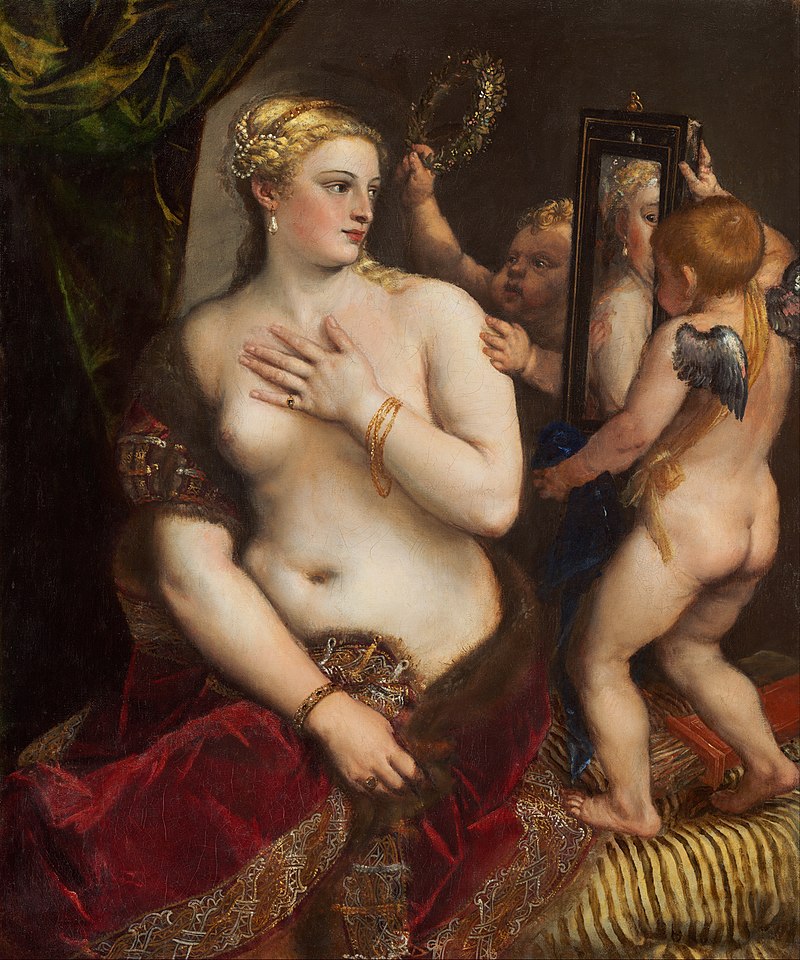
Titian’s Venus with a Mirror
Titian’s Venus with a Mirror: A Masterpiece of Beauty, Sensuality, and Symbolism
In the pantheon of art history, few images evoke as much fascination, allure, and contemplation as Titian’s “Venus with a Mirror.” This iconic masterpiece, painted by the Venetian Renaissance artist Titian (Tiziano Vecellio) in the early 16th century, embodies the essence of beauty, sensuality, and symbolism, inviting viewers on a journey of exploration through the complexities of love, desire, and self-reflection.
At first glance, the painting presents a scene of timeless elegance and allure. In the center of the composition stands Venus, the goddess of love and beauty, her luscious figure adorned with jewels and sumptuous fabrics. With one hand gracefully resting on her hip and the other holding a mirror, she gazes upon her reflection with a mixture of curiosity and self-assurance.
Yet, as we delve deeper into the painting, we begin to unravel its layers of meaning and symbolism. The mirror, with its polished surface and ornate frame, becomes a central motif that invites us to reflect on the nature of beauty, vanity, and self-awareness. In Venus’s gaze, we see not only the reflection of her physical form but also the reflection of her innermost thoughts and desires – a poignant reminder of the eternal quest for self-knowledge and self-acceptance.
One of the most striking aspects of Titian’s “Venus with a Mirror” is its masterful use of color, light, and composition to evoke a sense of sensuality and intimacy. The warm, golden hues of Venus’s skin glow with an inner radiance, while the richly textured fabrics and sumptuous drapery envelop her in a cocoon of luxury and comfort. Against the backdrop of a lush, verdant landscape, Venus emerges as a vision of timeless beauty and feminine grace, captivating the viewer with her magnetic presence.
But beyond its aesthetic appeal, “Venus with a Mirror” also carries deeper layers of symbolism and allegory. In Renaissance art, the figure of Venus was often used as a metaphor for love, desire, and the pursuit of earthly pleasures. By presenting Venus as a mortal woman rather than a divine goddess, Titian invites us to contemplate the human experience of love and desire – its joys, its complexities, and its inevitable transience.
Moreover, the mirror in Venus’s hand becomes a powerful symbol of self-reflection and introspection. As she gazes upon her own image, she confronts not only her physical appearance but also her innermost thoughts, fears, and desires. In this moment of contemplation, Venus becomes a mirror for the viewer, inviting us to confront our own notions of beauty, identity, and self-worth.
Throughout history, “Venus with a Mirror” has inspired countless interpretations and analyses, reflecting the timeless appeal and enduring relevance of its themes. From the sensuous allure of Venus’s form to the symbolic resonance of the mirror, the painting continues to captivate and intrigue audiences around the world, inviting us to explore the mysteries of love, desire, and self-discovery.
In conclusion, Titian’s “Venus with a Mirror” stands as a masterpiece of beauty, sensuality, and symbolism. Through its evocative imagery and profound themes, the painting invites viewers on a journey of exploration through the complexities of love, desire, and self-reflection. As we gaze upon Venus’s luminous figure and contemplate the mysteries of the mirror, we are reminded of the enduring power of art to illuminate the human experience and awaken the depths of our souls.




